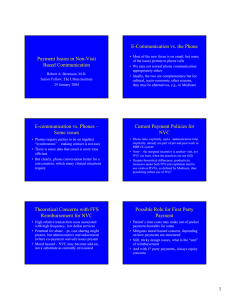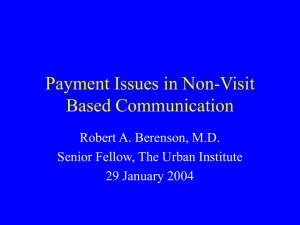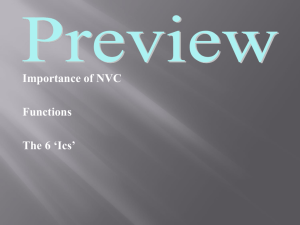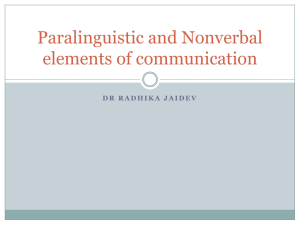Paying for Physician -- Patient Online Communication Robert A. Berenson, M.D.
advertisement
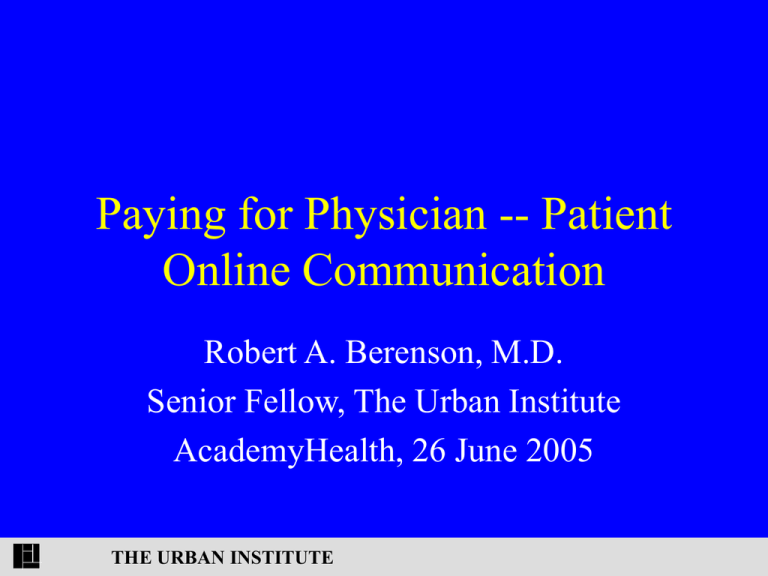
Paying for Physician -- Patient Online Communication Robert A. Berenson, M.D. Senior Fellow, The Urban Institute AcademyHealth, 26 June 2005 THE URBAN INSTITUTE E-Communication vs. the Phone • The new focus is on email/structured web visits, but phone calls raise similar payment issues • Ideally, the two are complementary but for cultural, socio-economic, and other reasons, they may be viewed as alternatives, e.g., with a poor or elderly population THE URBAN INSTITUTE Non-visit Communication (NVC) Also Includes the Phone • Phones require parties to be on together “synchronous” – making contact is not easy • There is some data suggesting that email is more time efficient • But clearly, a phone conversation is better for a conversation, which many clinical situations require • AND, not everyone is online THE URBAN INSTITUTE Current Payment Policies for NVC • Phone time, explicitly, and e-communication time, implicitly, are already are part of pre and post work in Medicare’s RBRVS-based payments • However, the marginal incentive is another visit, not NVC (at least, when practices are not full) • Despite theoretical differences, productivity measures under both FFS and capitation tend to use patients seen or RVUs, as defined by Medicare, thus penalizing substitution of NVC THE URBAN INSTITUTE Theoretical Concerns with Third Party Reimbursement for NVC • Relatively high transaction costs associated with high frequency, low dollar services • Potential for abuse – pt. cost sharing might protect, but administrative and inducement (if copayment waived) issues present • Moral hazard – NVC may become add-on, not the substitute currently envisioned by some THE URBAN INSTITUTE Possible Role for First Party Payment • Patient’s time costs may make out of pocket payment for NVC desirable for some • Mitigates moral hazard concern, depending on how payments are structured • Still, tricky design issues, what is the “unit” of reimbursement • And with 1st party payments, always equity concerns, as with “concierge care” THE URBAN INSTITUTE Potential Uses for Online or Ecommunication • Administrative – Rx refills, appointments, normal test results, referral requests, etc. • Clinical – – – – – – Q’s and A’s about a condition, treatment, etc. Report self-care information Monitoring chronic conditions Provide educational resources As a substitute for a visit – an “e-consultation” or webvisit (RelayHealth’s term) THE URBAN INSTITUTE “E-consultation” • Based on pilots some insurers have started reimbursing for an alternative to an office visit – use an intermediary platform, with safeguards re privacy, clinical information, documentation, etc. • AMA CPT panel last year provided a reimbursement code for “online medical consultation” • Insurers still have to decide whether to pay THE URBAN INSTITUTE Increasing Recognition By Private Payers • Prominent insurers which pay for an econsultation include: BS of Cal., BC/BS of Mass, Horizon BC/BS of N.J., BC/BS of Tenn., BC/BS of Fla., Empire BC/BS, Fallon HP, Providence HP of Portland, a few others • Typically, reimburse $20-$35 for a formal, platform-based electronic encounter, perhaps with a $5 co-payment • In FFS reimbursement, however, expansion beyond a structured consultation or visit not easy THE URBAN INSTITUTE Implications of Full Range of Internet-based Applications • Many of the potential uses are for administrative purposes and should not require additional payments – should be cost-effective if any scale in practice • Many of the potential applications should apply to non-physicians, e.g., disease management (phone as well), but no easy way to reimburse these in any FFS approach THE URBAN INSTITUTE Payment Options for NVC • Voluntary subscription for online communication (and associated services) • Fee-for-service payment for defined NVCs • Increase value of current E&M services • Capitation for professional services • Condition-specific care management fee • Pay for performance THE URBAN INSTITUTE Voluntary Subscription • Payment lies outside of insurance – could be FFS, but more likely put dollars on account that then is drawn down by the practice • Market-based solution, without need to standardize and regulate • Some patients and payers may view this as “double payments” • Concern about tiering, equity of access THE URBAN INSTITUTE Pay FFS for Defined NVCs • As noted, some insurers are now paying for a defined online consultation • But applies to relatively small portion of potential NVCs, and not to phone • Doesn’t require major change • Can try to assure that new payments are only for substitute services, not add-ons • Amenable to incremental expansion THE URBAN INSTITUTE Pay for Defined NVCs (cont.) • There are difficult boundary issues • Relatively high transaction costs • Limiting NVC payments to substitute services may limit potential, which may lie as much in frequent interactions for patients with chronic conditions as in a substitute visit • Concern about payment policy driving behavior to certain forms of online communication • Equity concerns, by age and class, but less than with a separate subscription THE URBAN INSTITUTE Increase Value of Current E&M Services to Accommodate NVC • Phone time already part of E&M RVUs • Could resurvey either avg. practice or practices that use more NVCs to recalibrate RVU weights • Could use alternative fee schedules for practices that use more or less of NVC • This is the most straightforward approach (unless distinguishing among practices) THE URBAN INSTITUTE Increasing Value of E&M (cont.) • BUT, THE MARGINAL INCENTIVE IS TO DO ANOTHER OFFICE VISIT AND NOT THE COMMUNICATION • No way to assure that the value of NVCs built into the rates are being provided • Modifying RVUs to incentivize desired M.D. behavior change would be new departure in basis for setting RVUs THE URBAN INSTITUTE Capitation • Decision to use NVC -- when and how -resides with the practice • Reduces unique FFS problems, incl. moral hazard, transaction costs, F&A • But capitation is declining • Capitation is permissive but passive, i.e., medical groups often use productivity measures that actually penalize NVC THE URBAN INSTITUTE Condition or Patient-Specific Care Management Fee • Modified form of capitation – essentially a monthly management fee that could require adherence to a set of processes • Might be targeted initially to care for patients with multiple chronic conditions • As with capitation, no preference for the form of NVC adopted and used • And NVC only one part of the package, e.g. see Wagner chronic care model THE URBAN INSTITUTE Care Management Fee (cont.) • Would the care management fee actually be used as intended? – gets us into a pay for performance or practice oversight situation • If properly applied, only subset of practices could qualify (but could serves as a stimulus to practice redesign?) • But applies only to some patients – assumes internal cross subsidies, but they might not happen THE URBAN INSTITUTE Pay for Performance • Could pay more for NVC structural processes measures, i.e, distinguishing among practices • Could pay for outcomes that might be better achieved with broader use of NVC • Reserves extra payments for those practices that earn the extra payments • Little experience with P4P for physicians THE URBAN INSTITUTE Pay for Performance (cont.) • Paying for NVC structure and process raises program integrity/ accountability issues • Paying for proximate outcomes, again, is a very indirect way for promoting NVC – would the payments be enough and would the practices cross-subsidize? • As with all P4P, concern about tiering, i.e., the “rich get richer” THE URBAN INSTITUTE

